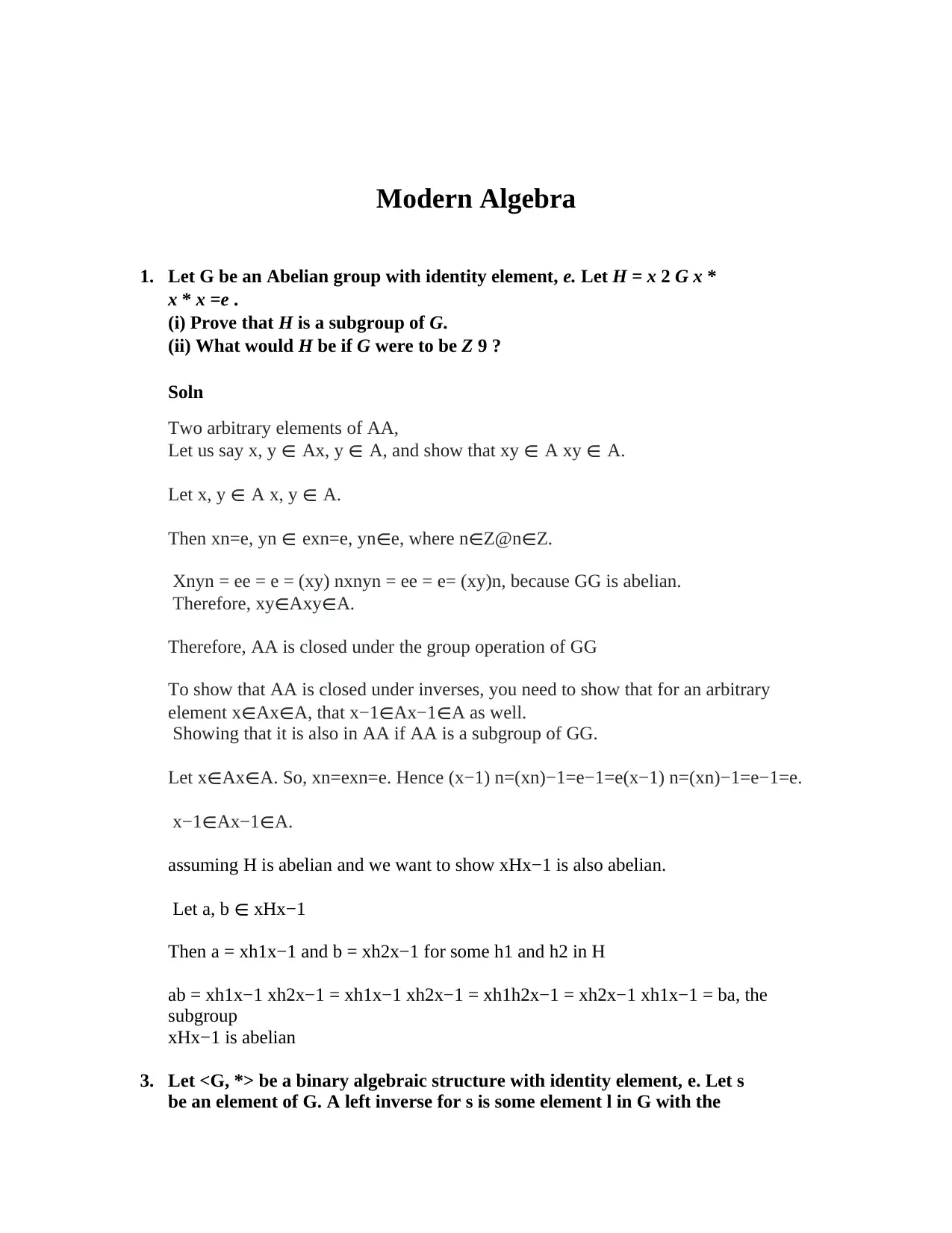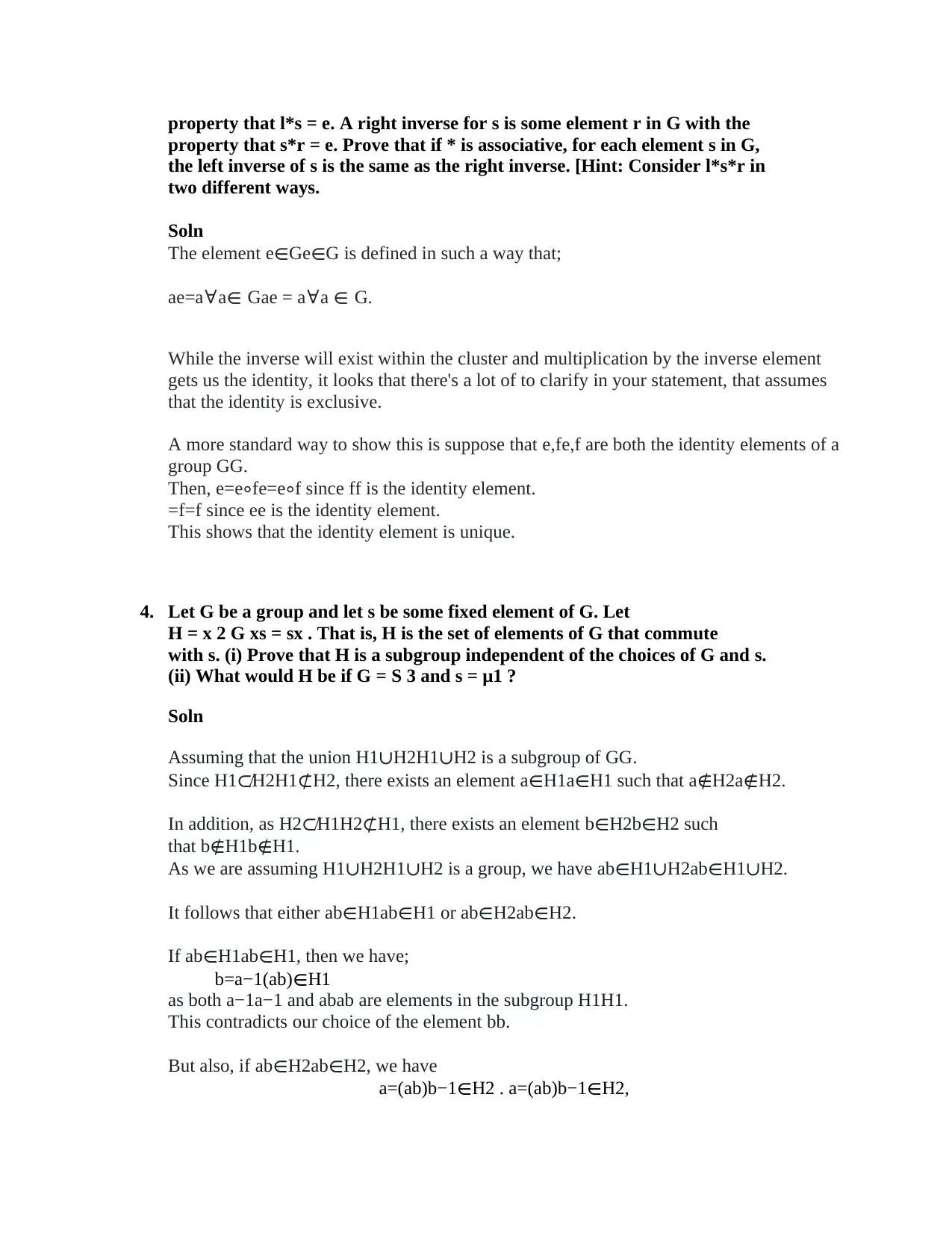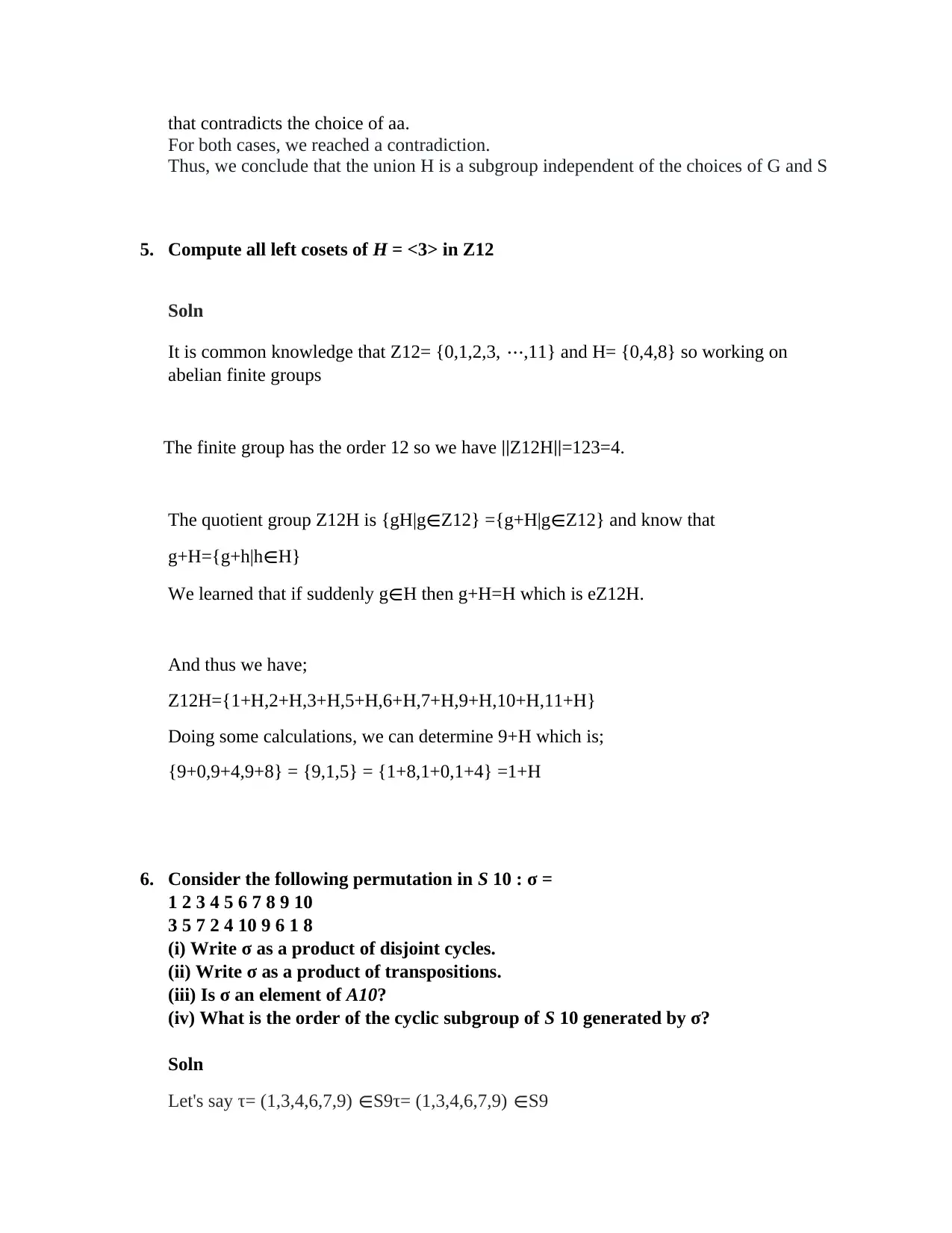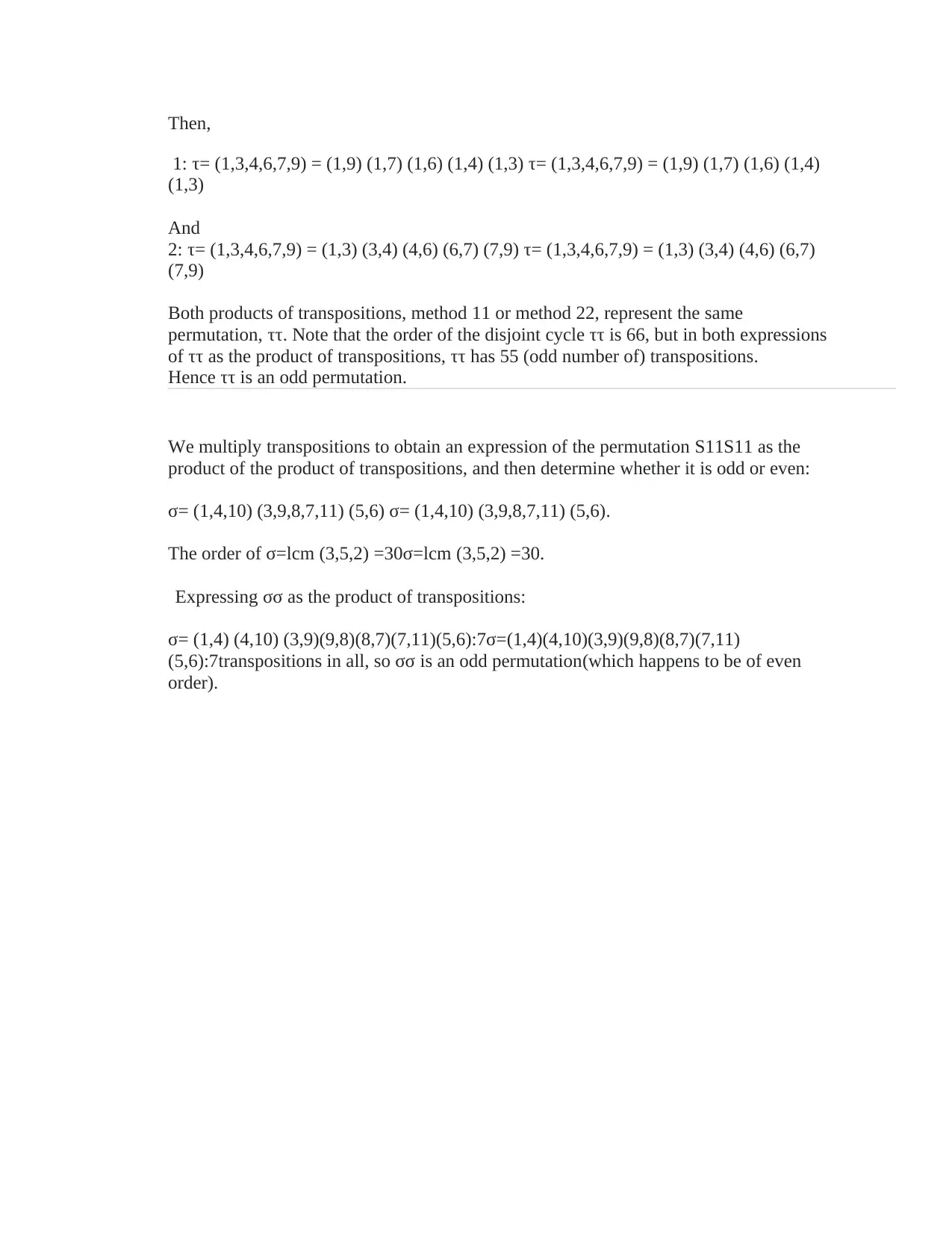Modern Algebra Homework Assignment on Group Theory Concepts
VerifiedAdded on 2022/12/27
|4
|1201
|24
Homework Assignment
AI Summary
This document presents a comprehensive solution to a modern algebra homework assignment, focusing on fundamental group theory concepts. The assignment explores subgroups, including proving properties of subgroups within Abelian groups, and determining subgroups within specific groups like Z9. It also addresses the uniqueness of identity elements and explores the properties of left and right inverses in algebraic structures. The solution includes detailed proofs and explanations for each problem, such as identifying left cosets and analyzing permutations, including expressing them as products of disjoint cycles and transpositions. The final problems delve into the order of cyclic subgroups and the properties of permutations within the symmetric group S10, providing a complete understanding of the topics covered.

Modern Algebra
1. Let G be an Abelian group with identity element, e. Let H = x 2 G x *
x * x =e .
(i) Prove that H is a subgroup of G.
(ii) What would H be if G were to be Z 9 ?
Soln
Two arbitrary elements of AA,
Let us say x, y ∈ Ax, y ∈ A, and show that xy ∈ A xy ∈ A.
Let x, y ∈ A x, y ∈ A.
Then xn=e, yn ∈ exn=e, yn∈e, where n∈Z@n∈Z.
Xnyn = ee = e = (xy) nxnyn = ee = e= (xy)n, because GG is abelian.
Therefore, xy∈Axy∈A.
Therefore, AA is closed under the group operation of GG
To show that AA is closed under inverses, you need to show that for an arbitrary
element x∈Ax∈A, that x−1∈Ax−1∈A as well.
Showing that it is also in AA if AA is a subgroup of GG.
Let x∈Ax∈A. So, xn=exn=e. Hence (x−1) n=(xn)−1=e−1=e(x−1) n=(xn)−1=e−1=e.
x−1∈Ax−1∈A.
assuming H is abelian and we want to show xHx−1 is also abelian.
Let a, b ∈ xHx−1
Then a = xh1x−1 and b = xh2x−1 for some h1 and h2 in H
ab = xh1x−1 xh2x−1 = xh1x−1 xh2x−1 = xh1h2x−1 = xh2x−1 xh1x−1 = ba, the
subgroup
xHx−1 is abelian
3. Let <G, *> be a binary algebraic structure with identity element, e. Let s
be an element of G. A left inverse for s is some element l in G with the
1. Let G be an Abelian group with identity element, e. Let H = x 2 G x *
x * x =e .
(i) Prove that H is a subgroup of G.
(ii) What would H be if G were to be Z 9 ?
Soln
Two arbitrary elements of AA,
Let us say x, y ∈ Ax, y ∈ A, and show that xy ∈ A xy ∈ A.
Let x, y ∈ A x, y ∈ A.
Then xn=e, yn ∈ exn=e, yn∈e, where n∈Z@n∈Z.
Xnyn = ee = e = (xy) nxnyn = ee = e= (xy)n, because GG is abelian.
Therefore, xy∈Axy∈A.
Therefore, AA is closed under the group operation of GG
To show that AA is closed under inverses, you need to show that for an arbitrary
element x∈Ax∈A, that x−1∈Ax−1∈A as well.
Showing that it is also in AA if AA is a subgroup of GG.
Let x∈Ax∈A. So, xn=exn=e. Hence (x−1) n=(xn)−1=e−1=e(x−1) n=(xn)−1=e−1=e.
x−1∈Ax−1∈A.
assuming H is abelian and we want to show xHx−1 is also abelian.
Let a, b ∈ xHx−1
Then a = xh1x−1 and b = xh2x−1 for some h1 and h2 in H
ab = xh1x−1 xh2x−1 = xh1x−1 xh2x−1 = xh1h2x−1 = xh2x−1 xh1x−1 = ba, the
subgroup
xHx−1 is abelian
3. Let <G, *> be a binary algebraic structure with identity element, e. Let s
be an element of G. A left inverse for s is some element l in G with the
Paraphrase This Document
Need a fresh take? Get an instant paraphrase of this document with our AI Paraphraser

property that l*s = e. A right inverse for s is some element r in G with the
property that s*r = e. Prove that if * is associative, for each element s in G,
the left inverse of s is the same as the right inverse. [Hint: Consider l*s*r in
two different ways.
Soln
The element e∈Ge∈G is defined in such a way that;
ae=a∀a∈ Gae = a∀a ∈ G.
While the inverse will exist within the cluster and multiplication by the inverse element
gets us the identity, it looks that there's a lot of to clarify in your statement, that assumes
that the identity is exclusive.
A more standard way to show this is suppose that e,fe,f are both the identity elements of a
group GG.
Then, e=e∘fe=e∘f since ff is the identity element.
=f=f since ee is the identity element.
This shows that the identity element is unique.
4. Let G be a group and let s be some fixed element of G. Let
H = x 2 G xs = sx . That is, H is the set of elements of G that commute
with s. (i) Prove that H is a subgroup independent of the choices of G and s.
(ii) What would H be if G = S 3 and s = μ1 ?
Soln
Assuming that the union H1∪H2H1∪H2 is a subgroup of GG.
Since H1⊄ H2H1⊄H2, there exists an element a∈H1a∈H1 such that a∉H2a∉H2.
In addition, as H2⊄ H1H2⊄H1, there exists an element b∈H2b∈H2 such
that b∉H1b∉H1.
As we are assuming H1∪H2H1∪H2 is a group, we have ab∈H1∪H2ab∈H1∪H2.
It follows that either ab∈H1ab∈H1 or ab∈H2ab∈H2.
If ab∈H1ab∈H1, then we have;
b=a−1(ab)∈H1
as both a−1a−1 and abab are elements in the subgroup H1H1.
This contradicts our choice of the element bb.
But also, if ab∈H2ab∈H2, we have
a=(ab)b−1∈H2 . a=(ab)b−1∈H2,
property that s*r = e. Prove that if * is associative, for each element s in G,
the left inverse of s is the same as the right inverse. [Hint: Consider l*s*r in
two different ways.
Soln
The element e∈Ge∈G is defined in such a way that;
ae=a∀a∈ Gae = a∀a ∈ G.
While the inverse will exist within the cluster and multiplication by the inverse element
gets us the identity, it looks that there's a lot of to clarify in your statement, that assumes
that the identity is exclusive.
A more standard way to show this is suppose that e,fe,f are both the identity elements of a
group GG.
Then, e=e∘fe=e∘f since ff is the identity element.
=f=f since ee is the identity element.
This shows that the identity element is unique.
4. Let G be a group and let s be some fixed element of G. Let
H = x 2 G xs = sx . That is, H is the set of elements of G that commute
with s. (i) Prove that H is a subgroup independent of the choices of G and s.
(ii) What would H be if G = S 3 and s = μ1 ?
Soln
Assuming that the union H1∪H2H1∪H2 is a subgroup of GG.
Since H1⊄ H2H1⊄H2, there exists an element a∈H1a∈H1 such that a∉H2a∉H2.
In addition, as H2⊄ H1H2⊄H1, there exists an element b∈H2b∈H2 such
that b∉H1b∉H1.
As we are assuming H1∪H2H1∪H2 is a group, we have ab∈H1∪H2ab∈H1∪H2.
It follows that either ab∈H1ab∈H1 or ab∈H2ab∈H2.
If ab∈H1ab∈H1, then we have;
b=a−1(ab)∈H1
as both a−1a−1 and abab are elements in the subgroup H1H1.
This contradicts our choice of the element bb.
But also, if ab∈H2ab∈H2, we have
a=(ab)b−1∈H2 . a=(ab)b−1∈H2,

that contradicts the choice of aa.
For both cases, we reached a contradiction.
Thus, we conclude that the union H is a subgroup independent of the choices of G and S
5. Compute all left cosets of H = <3> in Z12
Soln
It is common knowledge that Z12= {0,1,2,3, ⋯,11} and H= {0,4,8} so working on
abelian finite groups
The finite group has the order 12 so we have ∣∣Z12H∣∣=123=4.
The quotient group Z12H is {gH|g∈Z12} ={g+H|g∈Z12} and know that
g+H={g+h|h∈H}
We learned that if suddenly g∈H then g+H=H which is eZ12H.
And thus we have;
Z12H={1+H,2+H,3+H,5+H,6+H,7+H,9+H,10+H,11+H}
Doing some calculations, we can determine 9+H which is;
{9+0,9+4,9+8} = {9,1,5} = {1+8,1+0,1+4} =1+H
6. Consider the following permutation in S 10 : σ =
1 2 3 4 5 6 7 8 9 10
3 5 7 2 4 10 9 6 1 8
(i) Write σ as a product of disjoint cycles.
(ii) Write σ as a product of transpositions.
(iii) Is σ an element of A10?
(iv) What is the order of the cyclic subgroup of S 10 generated by σ?
Soln
Let's say τ= (1,3,4,6,7,9) ∈S9τ= (1,3,4,6,7,9) ∈S9
For both cases, we reached a contradiction.
Thus, we conclude that the union H is a subgroup independent of the choices of G and S
5. Compute all left cosets of H = <3> in Z12
Soln
It is common knowledge that Z12= {0,1,2,3, ⋯,11} and H= {0,4,8} so working on
abelian finite groups
The finite group has the order 12 so we have ∣∣Z12H∣∣=123=4.
The quotient group Z12H is {gH|g∈Z12} ={g+H|g∈Z12} and know that
g+H={g+h|h∈H}
We learned that if suddenly g∈H then g+H=H which is eZ12H.
And thus we have;
Z12H={1+H,2+H,3+H,5+H,6+H,7+H,9+H,10+H,11+H}
Doing some calculations, we can determine 9+H which is;
{9+0,9+4,9+8} = {9,1,5} = {1+8,1+0,1+4} =1+H
6. Consider the following permutation in S 10 : σ =
1 2 3 4 5 6 7 8 9 10
3 5 7 2 4 10 9 6 1 8
(i) Write σ as a product of disjoint cycles.
(ii) Write σ as a product of transpositions.
(iii) Is σ an element of A10?
(iv) What is the order of the cyclic subgroup of S 10 generated by σ?
Soln
Let's say τ= (1,3,4,6,7,9) ∈S9τ= (1,3,4,6,7,9) ∈S9
⊘ This is a preview!⊘
Do you want full access?
Subscribe today to unlock all pages.

Trusted by 1+ million students worldwide

Then,
1: τ= (1,3,4,6,7,9) = (1,9) (1,7) (1,6) (1,4) (1,3) τ= (1,3,4,6,7,9) = (1,9) (1,7) (1,6) (1,4)
(1,3)
And
2: τ= (1,3,4,6,7,9) = (1,3) (3,4) (4,6) (6,7) (7,9) τ= (1,3,4,6,7,9) = (1,3) (3,4) (4,6) (6,7)
(7,9)
Both products of transpositions, method 11 or method 22, represent the same
permutation, ττ. Note that the order of the disjoint cycle ττ is 66, but in both expressions
of ττ as the product of transpositions, ττ has 55 (odd number of) transpositions.
Hence ττ is an odd permutation.
We multiply transpositions to obtain an expression of the permutation S11S11 as the
product of the product of transpositions, and then determine whether it is odd or even:
σ= (1,4,10) (3,9,8,7,11) (5,6) σ= (1,4,10) (3,9,8,7,11) (5,6).
The order of σ=lcm (3,5,2) =30σ=lcm (3,5,2) =30.
Expressing σσ as the product of transpositions:
σ= (1,4) (4,10) (3,9)(9,8)(8,7)(7,11)(5,6):7σ=(1,4)(4,10)(3,9)(9,8)(8,7)(7,11)
(5,6):7transpositions in all, so σσ is an odd permutation(which happens to be of even
order).
1: τ= (1,3,4,6,7,9) = (1,9) (1,7) (1,6) (1,4) (1,3) τ= (1,3,4,6,7,9) = (1,9) (1,7) (1,6) (1,4)
(1,3)
And
2: τ= (1,3,4,6,7,9) = (1,3) (3,4) (4,6) (6,7) (7,9) τ= (1,3,4,6,7,9) = (1,3) (3,4) (4,6) (6,7)
(7,9)
Both products of transpositions, method 11 or method 22, represent the same
permutation, ττ. Note that the order of the disjoint cycle ττ is 66, but in both expressions
of ττ as the product of transpositions, ττ has 55 (odd number of) transpositions.
Hence ττ is an odd permutation.
We multiply transpositions to obtain an expression of the permutation S11S11 as the
product of the product of transpositions, and then determine whether it is odd or even:
σ= (1,4,10) (3,9,8,7,11) (5,6) σ= (1,4,10) (3,9,8,7,11) (5,6).
The order of σ=lcm (3,5,2) =30σ=lcm (3,5,2) =30.
Expressing σσ as the product of transpositions:
σ= (1,4) (4,10) (3,9)(9,8)(8,7)(7,11)(5,6):7σ=(1,4)(4,10)(3,9)(9,8)(8,7)(7,11)
(5,6):7transpositions in all, so σσ is an odd permutation(which happens to be of even
order).
1 out of 4
Related Documents
Your All-in-One AI-Powered Toolkit for Academic Success.
+13062052269
info@desklib.com
Available 24*7 on WhatsApp / Email
![[object Object]](/_next/static/media/star-bottom.7253800d.svg)
Unlock your academic potential
Copyright © 2020–2025 A2Z Services. All Rights Reserved. Developed and managed by ZUCOL.



